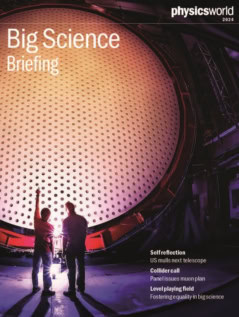Over the past decades, “big science” has become bigger than ever be it planning larger particle colliders, fusion tokamaks or space observatories. That development is reflected in the growth of the Big Science Business Forum (BSBF), which has been going from strength to strength following its first meeting in 2018 in Copenhagen.

This year, more than 1000 delegates from 500 organizations and 30 countries will descend on Trieste from 1 to 4 October for BSBF 2024. The meeting will see European businesses and organizations such as the European Southern Observatory, the CERN particle-physics laboratory and Fusion 4 Energy come together to discuss the latest developments and business trends in big science.
A key component of the event – as it was at the previous BSBF in Granada, Spain, in 2022 – is the Women in Big Science group, who will be giving a plenary session about initiatives to boost and help women in big science.
In this year’s Physics World Big Science Briefing, Elizabeth Pollitzer – co-founder and director of Portia, which seeks to improve gender equality in science, technology, engineering and mathematics.
She explains why we need gender equality in big science and what measures must be taken to tackle the gender imbalance among staff and users of large research infrastructures.
One prime example of big science is particle physics. Some 70 years since the founding of CERN and a decade following the discovery of the Higgs boson at the lab’s Large Hadron Collider (LHC) in 2012, particle physics stands at a crossroads. While the consensus is that a “Higgs factory” should come next after the LHC, there is disagreement over what kind of machine it should be – a large circular collider some 91 km in circumference or a linear machine just a few kilometres long.
As the wrangling goes on, other proposals are also being mooted such as a muon collider. Despite needing new technologies, a muon collider has the advantage that it would only require a circular collider in a tunnel roughly the size of the LHC.
Another huge multinational project is the ITER fusion tokamak currently under construction in Cadarache, France. Hit by cost hikes and delays for decades, there was more bad news earlier this year when ITER said the tokamak will now not fire up until 2035. ”Full power” mode with deuterium and tritium won’t happen until 2039 some 50 years since the facility was first mooted.
Backers hope that ITER will lay the way towards fusion power plants delivering electricity to the grid, but huge technical challenges lie in store. After all, those reactors will have to breed their own tritium so they become fuel independent, as John Evans explains.
Big science also involves dedicated user facilities. In this briefing we talk to Gianluigi Botton from the Diamond Light Source in the UK and Mike Witherell from the Lawrence Berkeley National Laboratory on managing such large scale research infrastructures and their plans for the future.
We hope you enjoy the briefing and let us know your feedback on the issue.



